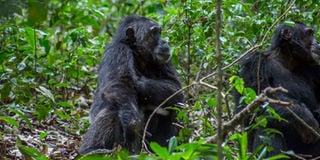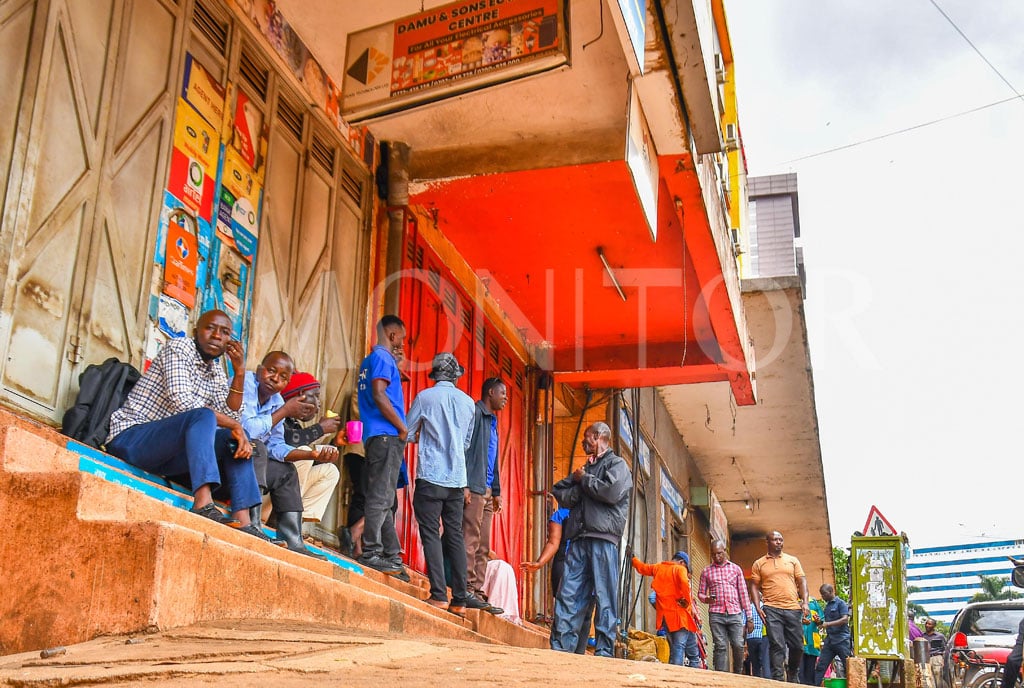A date with chimps in Kibale

RELIC: Chimpanzees in Kibale Forest recently. PHOTO BY Eric Ntalumbwa.
What you need to know:
Venture: We enjoyed time with the primates, writes ERIC NTALUMBWA.
For years the biodiverse Kibale National Park languished off the safari itinerary, but with the help of conservationists and forward-thinking investors, tourists have a chance to sample, at first hand, the brightest jewel in the crown of Kibale-the Chimpanzees.
The thoughts of the defeaning chant of “Tooro Kokasemera”, a slogan in native Rutooro language translated as “Beautiful Tooro” crossed my mind as I snacked on crunchy corn and sipped fresh mango juice in the coaster. About 30 conservation media campers were on their way to Tinka’s Homestay in Bigodi on the edge of the lush forested surrounding of primate capital of the world.
“What makes Kibale a fascinating destination for tourists?” Emmanuel Lovati asked. I smiled and asked him to prepare his Canon camera for some wildlife and landscape photography. We crossed Mpanga river, the main source of water for Fort Portal, and turned right to Kamwenge District.
Fort Portal is a four-hour journey, approximately 317km to the west of Kampala and 80km north of Kasese. Fort Portal is nestled in the foothills of the mist-shrouded Rwenzori Mountains. Clean, refreshing and beautiful is the most befitting description of the town.
It takes about 35 minutes from Fort Portal to Bigodi on Kamwenge road. However, if you are a real tourist, stand warned because the picturesque landscape will always slow down the journey for selfie moments. The widespread tea plantations, and crater lakes reflect the richness and diversity of Tooro’s beauty.
The congress of baboons along the road captures the soul of Kibale Forest, as a primate haven. Women and men pick tea leaves and carry loaded baskets of the cash crop, a source of economic livelihood in their families. The scenic beauty re-created the thrill of adventure in pursuit of our closest relatives.
Tinka’s homestay is a story of how total immersion in a local family can change our understanding of the community and tourism. John Tinka offers more than a bed, it is an experience for visitors willing to share his house during their visit to Kibale National Park. In return, the visitors benefit from the affordable prices and high level of hospitality.
Camping at Tinka’s home stay gives the visitors an opportunity to share the rich knowledge and background of the local village that has transformed as a result of Bigodi Wetland Sanctuary, a community owned tourism project. The women checked into the guest house as the boys pitched camp in the terrace gardens.
The walk
The following day after breakfast, we set off to Bigodi Wetland Sanctuary and Magombe swamp. This attraction is managed by Kibale Association For Rural Development (Kafred), a community-based organisation that supports ecotourism initiatives. Bigodi is derived from kugodya, a Rutooro word to mean ‘walk in a tired way’. It is argued that when visitors reached this place on foot, they appeared exhausted and could not walk any further.
The sanctuary guide Robert Bagonza requested us to wear closed shoes and tuck our trousers’ hems into socks to protect us against safari ants. He led us to a walk in the swamp along a trail with boardwalks. During the walk, he informed us that the sanctuary has a number of butterflies and eight primates, including the black and white colobus, mangabey, L’Hoest and red tailed monkey, which consider the swamp a habitat.
The dominant rich papyrus vegetation and tree species such as polita figs and wild palms are undeniably a gift of nature. The wetland has more than 200 bird species, including the Kingfisher, hornbills and the great blue turaco. The great blue turaco is known to be loyal in its relationship vows; when it loses a partner, it stays single. A swamp walk cost Shs10,000 for Ugandans, $25 (about Shs90,000) for non-residents of Uganda (East Africans) and foreigners are expected to part with Shs140,000.
Towards midday, we drove to Kanyanchu visitor centre for briefing before we embarked on Chimp Tracking in Kibale National Park. Established in 1993, the medium altitude tropical rain forest boasts 13 species of primates such as Olive Baboon, Red tailed monkey, Uganda Mangabey; 372 birds;350 tree species and 71 mammals. The park has an estimated population of 1450 chimpanzees in more than 13 chimpanzee communities. The wanderlust magazine published on November 11, 2018 placed Kibaale among the top seven places to track chimps in the wild.
The habituated lot
Godfrey Balyesiima, Uganda Wildlife Authority warden of tourism, briefed us that park had two groups of habituated chimpanzees that can be tracked.
“The ranger guide will take you to a community of chimpanzees that are used to people and once you find them through different methods, then you are allowed to to stay with them for only one single hour and then you come back,” he said.
Chimpanzees are endangered species and it is not recommended to stay with them for a long time. We were divided into groups of six and each team led by a ranger guide armed with an AK47 hanging over his shoulder. As the ranger described the various flora in the park, he kept a close eye just in case he detected the primates and also listened attentively to the radio call communications.
After more than an hour of trekking and hiking through the forest, all groups converged at a community of wild chimpanzees. Unfit trackers heaved a sigh of relief!
Activities you can do at kibale
Nocturnal forest walk
The night forest walk takes place after dinner in Kibale Forest. You are guided by Uganda Wildlife rangers equipped with spotlights to see the forest come alive at night. You can see the creatures of the night such as bush babies, pottos, at times tree pangolins and other nocturnal animal in the forest.
Chimp habituation
The chimpanzee habituation experience begins early in the morning and lasts all-day long – you are with a guide, researchers, trackers and others as you are in the presence of chimpanzees being habituated.
Not only will you see Chimpanzees, but other primates, birds, butterflies, trees, and mammals.
Children activities
Children under the age of 15 cannot track chimpanzees. Children -friendly rangers will show the children the wonders of the forest, show them wildlife, plants, trees, birds, and monkeys. Kibale Forest is one of the few places where children can take bushcraft classes.




